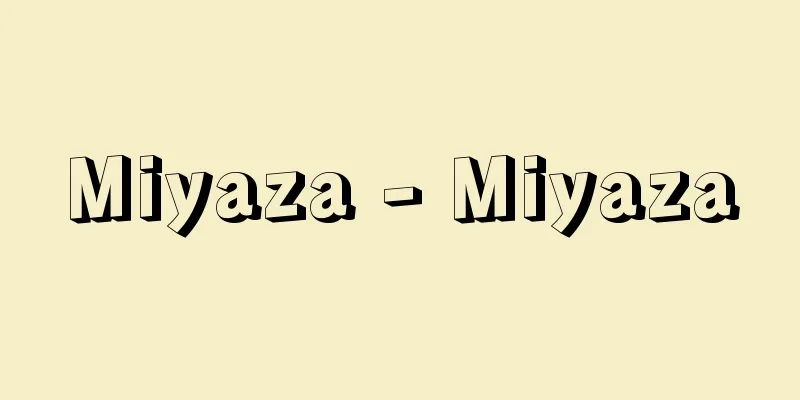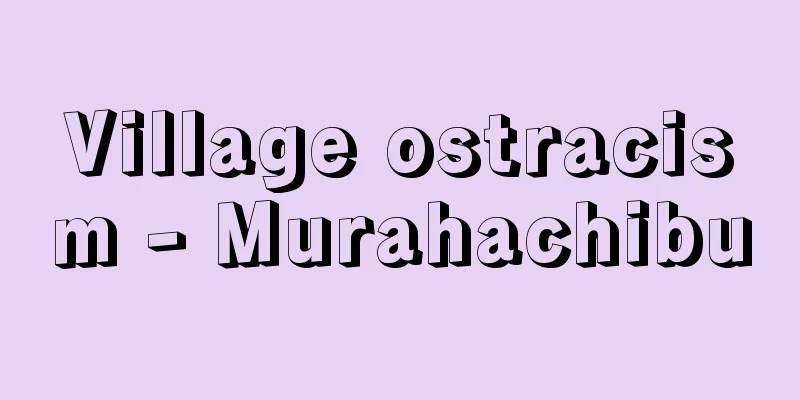Miyaza - Miyaza

|
A collective organization within the parishioners that has exclusive rights to manage the village ujigami and perform the rituals. A ritual association. The term Miyaza is said to have meant a group of people who could occupy the limited seats in front of the altar, but it is closely related to economic za (trade associations) such as the oil za and paper za of the Middle Ages. It is not clear which was the original Miyaza, the economic za or the ritual association, but in the olden days there was a village organization equivalent to the za, and politics and economy were run around the village ujigami, but when they became independent, only the shrine-centered organization remained as Miyaza. The term Miyaza began to be used frequently around the 15th century (mid-Muromachi period). Currently, Miyaza is only used in the areas from Kinki to Kitakyushu, but similar organizations are distributed much more widely, and are called by various names such as Miya nakama, To nakama, Matsuri nakama, Musubi shu, Miyashu, Shaninshu, Miyakabu, Tokabu, Moroto, Miyasuji, Miyakata, Miyako, etc. For example, in a village in Takashima City, Shiga Prefecture, there are two Miyaza (a shrine that performs the rituals for the local deity). The one organized by the indigenous people from long ago is called the Moroto Kabu, and the one organized by people who moved from outside the village during the time is called the Waki Kabu. The Moroto Kabu must have enough assets to bear the cost of the rituals. In the past, the distinction between Moroto and Waki was clear, and they did not marry each other. Even at the initiation ceremony for the youth association, the son of a Waki Kabu could not sit in the upper seat than the middle floor, even if he was older. Until 1944 (Showa 19), those who had land holdings of mountains and rice fields valued at 100 yen or more and who had been living in the village for a long time were called Moroto. As the Pacific War drew to an end, the men of the village were drafted into military service, and there were fewer people to perform the rituals, so the scope of Moroto was expanded to a land value of 30 yen. As this example makes clear, while a Miyaza was originally made up of a single stock or family, there are cases where multiple Miyaza existed due to the movement of residents, and the appearance of these varies depending on the circumstances of each village. Within a Miyaza, there is a hierarchy based on age, and family background and years of experience are also important, with many cases where hierarchical distinctions are made between "adults," "middle-aged elders," and "young people." Before the modern system of full-time Shinto priests was established, Shinto priests (kannushi) were selected from within the Miyaza, and those who took turns were called one-year kannushi. In any case, the monopoly and discrimination held by Miyaza is difficult to accept in modern society, and there are many situations in which it is difficult for them to continue. [Shoji Inoguchi] "A Study of Miyaza by Higo Kazuo (1941, Kobundo)" ▽ "A Study of Medieval Ritual Organizations by Hagiwara Tatsuo (1962, Yoshikawa Kobunkan)" ▽ "A Historical Study of Miyaza and Villages by Takamaki Minoru (1986, Yoshikawa Kobunkan)" ▽ "The Historical Development of Miyaza in the Early Modern Period by Ando Seiichi (2005, Yoshikawa Kobunkan)" [Reference item] | | | |Source: Shogakukan Encyclopedia Nipponica About Encyclopedia Nipponica Information | Legend |
|
村氏神の経営や神事執行に関して、独占的な権利をもつ氏子内の集団組織。神事組合。宮座という呼称については、神前の限られた座席を占めることのできる仲間の意味であったともいわれるが、中世の油座・紙座など経済的な座(同業組合)の組織と密接な関係をもつ。経済的な座と神事組合としての宮座と、どちらが元かは明らかでないが、古くは村の組織として座に相当するものがあり、村氏神を中心に政治も経済も運営されていたのが、それぞれ独立したために神社中心の組織だけが宮座として残されたのであろう。宮座という呼び方は15世紀(室町時代中期)ごろから盛んに使われるようになってくる。現在、宮座とよんでいるのは、近畿から北九州にかけての地方に限られているが、同様の組織ははるかに広く分布しており、宮仲間、当(とう)仲間、祭り仲間、結(むすび)衆、宮衆、社人衆、宮株、当株、諸戸(もろと)、宮筋、宮方、宮講など種々の呼び方がある。 滋賀県高島市のある集落を例にとると、氏神の神事を務める宮座が二つある。古くからの土着の人々が組織しているのをモロト株、途中で村外から移住してきた人々のをワキ株という。モロト株は神事に費用がかかるので、その負担に耐えるだけの資産をもっていなければならない。昔はモロトとワキとの差別が判然としており、互いに縁組みをすることもなかった。青年会の入会式のようなときでも、ワキ株の息子は年齢が上であっても、部屋を打ち抜いた中敷より上座には座れなかった。1944年(昭和19)までは、山と田の持ち地の評価が総額100円以上で、元からこのムラに住み着いている者をモロトといった。太平洋戦争が終末に近づいて、ムラの男が兵役に狩り出され、神事を務める人が少なくなってしまったので、地価30円までとしてモロトの範囲を広げた。 この例で明らかなように、宮座は一株・一族で構成された形から、住民の移動によって複数の座が並立することがあり、その様相は各村の事情によって各様である。一つの宮座のなかでは年齢による序列があるほか、家柄や経験年数も重視され、「おとな」「中老」「若衆」などの階層を区別する例が多い。近代に専業神職制が成立する以前は、宮座のなかから神主(かんぬし)を選び、交替制のものを一年神主とよんだ。いずれにしても宮座の抱える独占・差別は現代社会に受け入れられにくく、存続が困難な場面が多くなっている。 [井之口章次] 『肥後和男著『宮座の研究』(1941・弘文堂)』▽『萩原龍夫著『中世祭祀組織の研究』(1962・吉川弘文館)』▽『高牧実著『宮座と村落の史的研究』(1986・吉川弘文館)』▽『安藤精一著『近世宮座の史的展開』(2005・吉川弘文館)』 [参照項目] | | | |出典 小学館 日本大百科全書(ニッポニカ)日本大百科全書(ニッポニカ)について 情報 | 凡例 |
<<: Miyazaki Prefecture - Miyazaki
Recommend
enmein
…It is distributed in Hokkaido, Honshu, Shikoku, ...
Fermentation industry
An industry that utilizes the ability of microorga...
Najah (English spelling)
...The Ismailis became active from the end of the...
mammary pouch
…In males, the mammary glands are vestigial, but ...
α-Methyldopa - α-methyldopa
...Of the many alpha receptor blockers, prazosin ...
meonizm
…He started out as a poet of the so-called bourge...
Katsu Kokichi
Year of death: September 4, 1850 (October 9, 1850)...
Ifugao - Ifugao people (English spelling)
A Malay ethnic group living in the Cordillera Cent...
Rostrum
…The mandibles and mandibles of mosquitoes, toget...
Astasia
…Some species of Euglena, such as E. gracilis Kle...
Cytoplasmic inheritance
Inheritance of traits controlled by genes in the ...
Udgātṛ (English spelling) Udgatr
…It is a sacred text of Brahmanism, one of the fo...
Steinitz, W.
...Others have pointed out its connection with th...
Sammuramat
...Afterwards, she conquered Egypt and finally in...
Usucha Temae - Usucha Temae
〘Noun〙 The manner of making thin tea in the tea ce...









